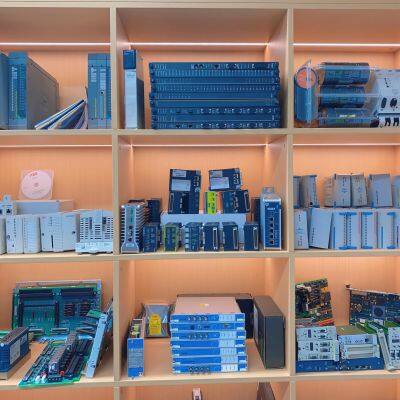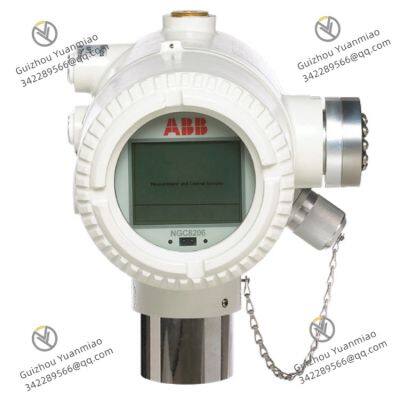Product Description
ABB CI873 3BSE092695R1 Communication Interface
NGC8206 is a compact on-line natural gas chromatograph developed by ABB specifically for the natural gas industry. It focuses on three core advantages: "high-precision analysis, low-power operation, and high-reliability deployment," enabling real-time detection and calculation of key parameters such as natural gas composition, calorific value, and physical properties. Designed to adapt to complex industrial on-site environments, it is widely used in the entire industrial chain scenarios of natural gas exploration, pipeline transportation, storage, custody transfer, and end-use, providing data support for natural gas quality control, metrological settlement, and safe operation. The following sections elaborate on it from dimensions including product positioning, core functions, technical parameters, hardware structure, application scenarios, and operation & maintenance characteristics.
I. Product Positioning and Core Advantages
NGC8206 is positioned as an "all-parameter on-line analysis solution for natural gas." Addressing the pain points of traditional chromatographs such as large size, high power consumption, and frequent maintenance, it adopts miniaturized chromatographic column technology, low-power detectors, and a modular design, combining laboratory-level analysis accuracy with industrial-grade on-site adaptability. Its core advantages can be summarized as follows:
"Small yet Precise": With a volume of only 1.1 cubic feet (approximately 31.15 liters), it can be directly installed in narrow spaces such as beside pipelines and pressure regulating stations, eliminating the need for a dedicated analysis cabin.
"Stable and Economical": It has a power consumption of ≤7W and low carrier gas consumption (minimum 15mL/min). Its operating cost is only 1/5 that of traditional chromatographs, and it has no vulnerable moving parts, resulting in a low failure rate.
"Comprehensive and Accurate": It covers the full composition analysis of natural gas from N₂ to C₆⁺, and simultaneously calculates key custody transfer parameters such as calorific value and relative density. Its accuracy meets the requirements of international standards (e.g., AGA 8, ISO 6976).

II. Core Functions and Analytical Capabilities1. Accurate Full-Composition Analysis
NGC8206 enables the separation and quantitative analysis of conventional and special components in natural gas, covering the core indicators for natural gas quality evaluation. The specific analysis scope is as follows:
2. Calculation of Key Physical Parameters
Based on the composition analysis results, NGC8206 can automatically calculate the core physical parameters required for natural gas custody transfer and combustion efficiency evaluation, fully complying with the requirements of international standard algorithms:
3. Data Management and Communication Capabilities
Real-Time Data Output: Supports 4~20mA analog signals (up to 8 channels, corresponding to different components or calculated parameters), RS-485 (Modbus RTU protocol), and Ethernet (Modbus TCP/IP protocol), which can be directly connected to SCADA, DCS, or natural gas metering systems.
Historical Data Storage: Built-in 2GB storage space, which can store analysis results at intervals of 1~60 minutes. Data retention time is ≥1 year, and it supports exporting files in Excel or CSV format via USB interface.
Remote Control and Diagnosis: Remote start of analysis, modification of method parameters, viewing of chromatograms, and fault alarms can be realized via Ethernet, reducing on-site operation and maintenance workload.
4. Operation and Automation Functions
Human-Machine Interaction (HMI): Full-function operation is realized through ABB's dedicated software PCCU 32 (based on Windows 2000/NT system), supporting wizard-style method editing, real-time chromatogram display, data trend analysis, and report generation. No professional chromatography knowledge is required for operation.
Automatic Calibration: Supports scheduled automatic calibration (daily/weekly calibration can be set). It realizes automatic correction of component concentration and calculated parameters through an external standard gas cylinder, ensuring long-term analysis accuracy.
Fault Self-Diagnosis: Real-time monitoring of key indicators such as carrier gas pressure, column temperature, and detector status. When faults such as carrier gas interruption and abnormal temperature occur, it immediately triggers an audible and visual alarm (optional) and outputs a fault code (e.g., "E101 - Low Carrier Gas Pressure," "E203 - Column Temperature Overrun").

III. Detailed Technical Parameters
1. Analytical Performance Parameters
2. Hardware and Operation Parameters
3. Environmental and Installation Parameters
IV. Hardware Structure and Modular Design
NGC8206 adopts a "functional modularization and integration" hardware architecture. Its core components are arranged according to the "sample processing - separation - detection - control" process, facilitating maintenance and upgrades. The specific structure is as follows:
1. Sample Pretreatment Module
Function: Removes moisture, particulate impurities, and heavy hydrocarbon condensates from the sample to ensure the sample entering the chromatographic column is clean and stable.
Composition: Built-in precision filter (filtration accuracy 2μm), dehydrator (based on Nafion membrane drying technology, no consumables), and pressure regulator (pressure stabilization accuracy ±0.01MPa). No external pretreatment system is required, simplifying on-site installation.
2. Injection and Separation Module
Dual 10-Port Injection Valve: Driven by a solenoid valve, it realizes automatic control of sample injection and carrier gas switching. It has no mechanically worn parts and is suitable for frequent start-stop working conditions.
Miniaturized Chromatographic Column: Uses stainless steel column tubes (inner diameter 0.53mm) filled with high-efficiency stationary phases, enabling rapid component separation (e.g., separation time between C₁ and N₂ ≤30 seconds). With small column volume and low heat capacity, its energy consumption is only 1/3 that of traditional chromatographic columns.
3. Detection and Signal Processing Module
Thermal Conductivity Detector (TCD): Glass-encapsulated spherical thermistors are used as detection elements, featuring high sensitivity (minimum response value 10μV/ppm). Unlike traditional metal-wire TCDs that are prone to burnout, it will not burn out when carrier gas is interrupted, extending its service life to more than 5 years.
Signal Amplifier: 16-bit high-precision analog-to-digital conversion (ADC) with a sampling rate of 100Hz, which can effectively suppress baseline noise and ensure accurate detection of low-concentration components (e.g., ppm-level H₂S).
4. Control and Communication Module
Main Controller: 32-bit embedded processor (based on Windows CE system), responsible for controlling injection valve switching, column temperature adjustment, data collection, and calculation, with a response time ≤10ms.
Communication Interface Board: Integrates RS-485, Ethernet, and 4~20mA analog output interfaces, supporting multiple industrial communication protocols and enabling flexible connection to different upper-level systems.
Status Indicator Lights: Four LED lights (Power (PWR), Run (RUN), Alarm (ALM), and Communication (COM)) are installed on the front panel to intuitively reflect the equipment's operating status.
V. Application Scenarios and Typical Deployments1. Natural Gas Custody Transfer
Application Requirement: In custody transfer, parameters such as natural gas calorific value and relative density need to be accurately measured as the basis for settlement (a 1% error in calorific value can lead to a settlement deviation of millions of US dollars).
Deployment Method: Installed at long-distance pipeline offloading stations, LNG receiving terminals, or city gate stations, and linked with ultrasonic flowmeters and pressure/temperature transmitters to calculate real-time standard volumetric flow (in accordance with AGA 9 standard).
Core Value: Its analysis accuracy meets the requirements of OIML R140 (custody metering level), and the data can be directly used for international natural gas custody settlement, avoiding metrological disputes.
2. Pipeline Natural Gas Quality Monitoring
Application Requirement: During long-distance transportation of natural gas, it is necessary to monitor changes in composition (e.g., excessively high C₆⁺ content may cause condensate deposition and pipeline blockage).
Deployment Method: One NGC8206 is installed every 50~100 kilometers along the pipeline, and centralized data monitoring is realized through the SCADA system.
Core Value: When C₆⁺ content exceeds 0.5% or H₂S content exceeds 20ppm, it automatically triggers an alarm, reminding operation and maintenance personnel to adjust transportation parameters (e.g., heating the pipeline, adding inhibitors).
3. Natural Gas End-Use
Industrial Combustion: Installed beside gas-fired boilers in iron and steel, chemical, and other enterprises. It monitors changes in natural gas calorific value in real time and automatically adjusts the air-fuel ratio to ensure combustion efficiency (which can be increased by 1~2%) and reduce energy consumption.
LNG Production: Installed at the feed gas inlet of LNG liquefaction plants to analyze N₂ and CO₂ content (N₂ >1% will reduce LNG production, and CO₂ >50ppm is prone to forming dry ice and blocking heat exchangers), ensuring the stability of the liquefaction process.
4. Environmental Protection and Emission Monitoring
Application Requirement: Natural gas processing plants and refueling stations need to monitor the content of CH₄ and CO₂ in process tail gas and combustion exhaust gas to meet environmental regulatory requirements (e.g., restrictions on methane emissions in China's Natural Gas Utilization Policy).
Deployment Method: Connected to the emission port through a sampling pipeline, NGC8206 analyzes the composition of exhaust gas in real time and uploads the data to the environmental monitoring platform.
Core Value: The detection data can be used as proof of enterprises' compliance with environmental protection regulations, and it also helps identify methane leakage points (e.g., a sudden increase in CH₄ concentration in exhaust gas may indicate equipment leakage).


ABB 086444-005 Measurement Process Board
ABB RMU610 2VAA008425R1 Repeater Mounting Unit
ABB CHBX01L 2VAA008574R1 Compact Bus Extender
ABB CHBX01R 2VAA008575R1 Compact Bus Extender
ABB UFC921A 3BHE024856P106 Communication Module
ABB PP886 3BSE092980R1 Operation Panel
ABB SUE3000 1VCF750090R0804 Maintenance Exchange Unit
ABB SUE3000 1VCR007346 G0032 REF542plus HMI Unit
ABB GFD563A101 Interface Module
ABB 3BHE046836R0101 Interface Module
ABB UNS0881b-PV2 PCB Circuit Board
ABB 3BHE050077R0102 PCB Circuit Board
 yezi
Hi there! Welcome to my shop. Let me know if you have any questions.
yezi
Hi there! Welcome to my shop. Let me know if you have any questions.




